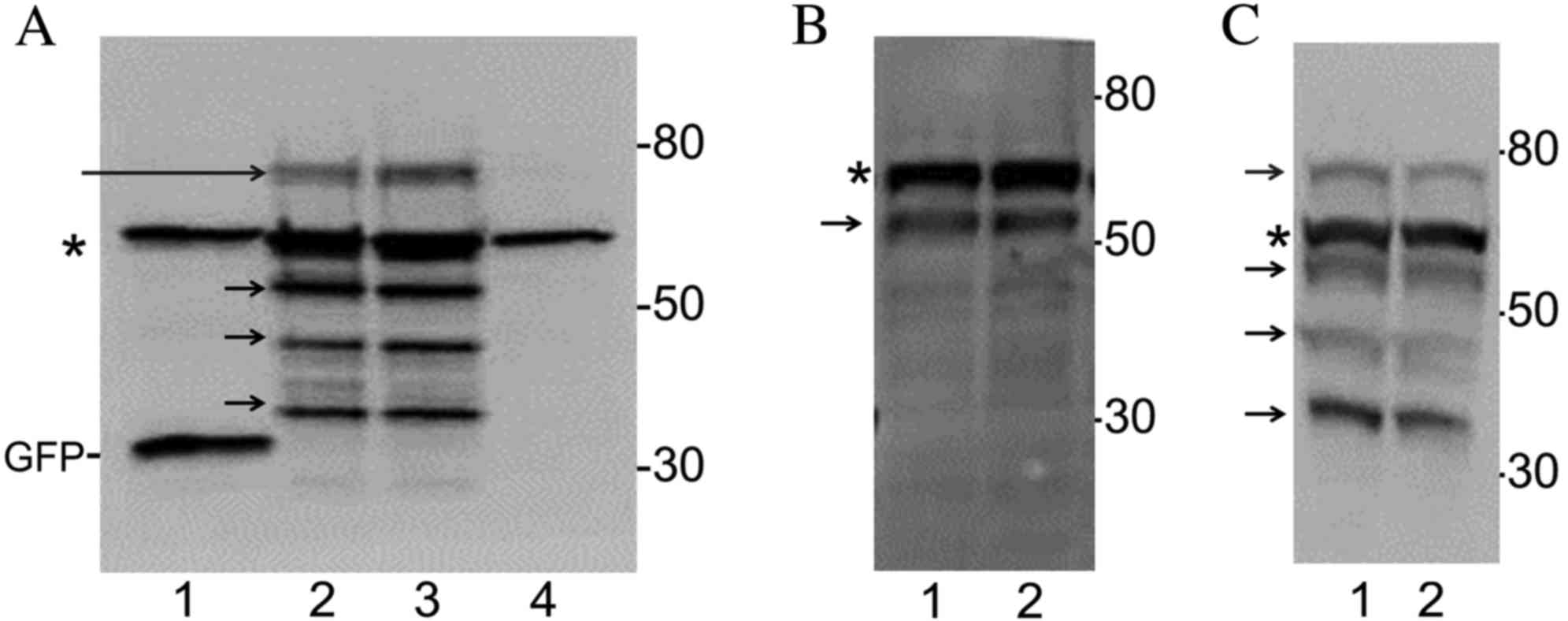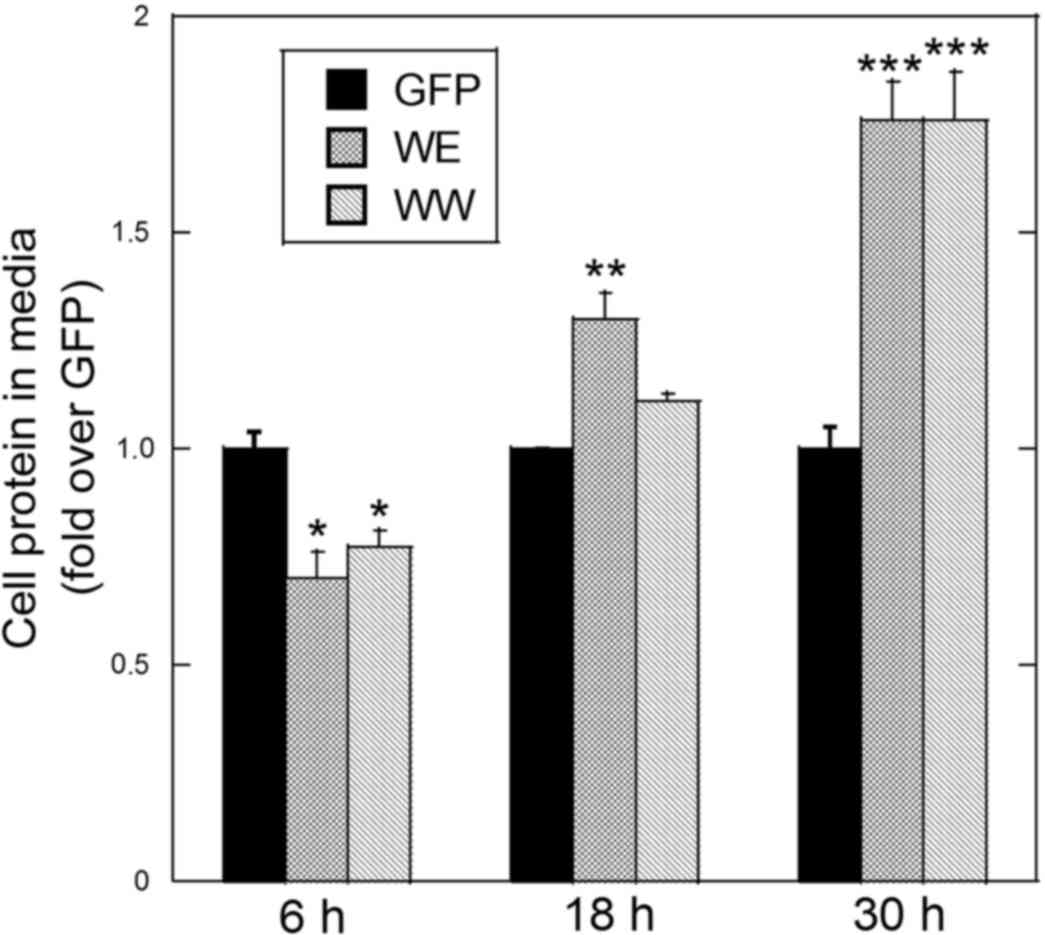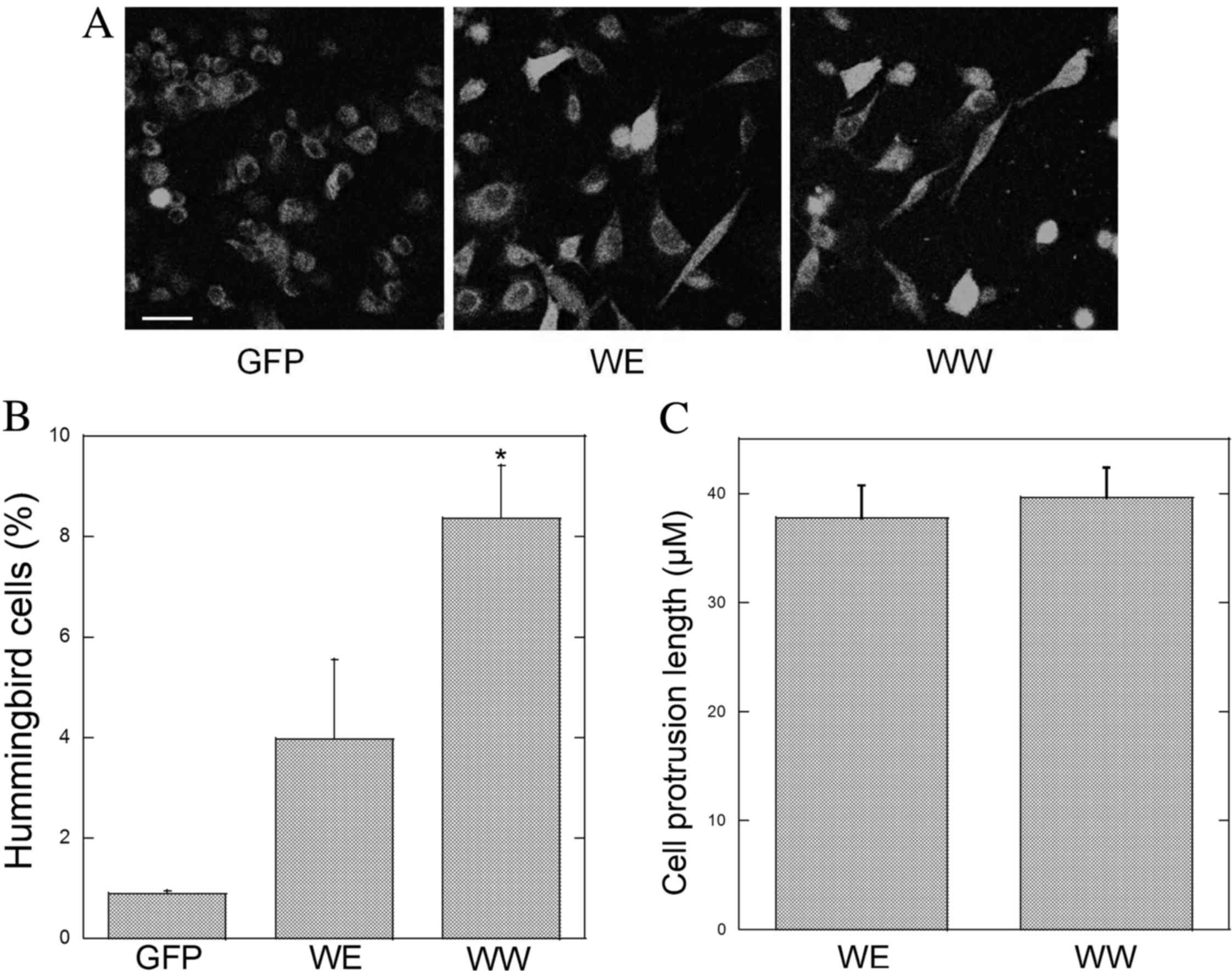|
1
|
Qadri Q, Rasool R, Gulzar GM, Naqash S and
Shah ZA: H. pylori infection, inflammation and gastric cancer. J
Gastrointest Cancer. 45:126–132. 2014. View Article : Google Scholar : PubMed/NCBI
|
|
2
|
Torre LA, Bray F, Siegel RL, Ferlay J,
Lortet-Tieulent J and Jemal A: Global cancer statistics, 2012. CA
Cancer J Clin. 65:87–108. 2015. View Article : Google Scholar : PubMed/NCBI
|
|
3
|
Covacci A, Censini S, Bugnoli M, Petracca
R, Burroni D, Macchia G, Massone A, Papini E, Xiang Z and Figura N:
Molecular characterization of the 128-kDa immunodominant antigen of
Helicobacter pylori associated with cytotoxicity and duodenal
ulcer. Proc Natl Acad Sci USA. 90:5791–5795. 1993. View Article : Google Scholar : PubMed/NCBI
|
|
4
|
Tummuru MK, Cover TL and Blaser MJ:
Cloning and expression of a high-molecular-mass major antigen of
Helicobacter pylori: Evidence of linkage to cytotoxin production.
Infect Immun. 61:1799–1809. 1993.PubMed/NCBI
|
|
5
|
Brenner H, Arndt V, Stegmaier C, Ziegler H
and Rothenbacher D: Is Helicobacter pylori infection a necessary
condition for noncardia gastric cancer? Am J Epidemiol.
159:252–258. 2004. View Article : Google Scholar : PubMed/NCBI
|
|
6
|
Hatakeyama M and Higashi H: Helicobacter
pylori CagA: A new paradigm for bacterial carcinogenesis. Cancer
Sci. 96:835–843. 2005. View Article : Google Scholar : PubMed/NCBI
|
|
7
|
Stein M, Bagnoli F, Halenbeck R, Rappuoli
R, Fantl WJ and Covacci A: c-Src/Lyn kinases activate Helicobacter
pylori CagA through tyrosine phosphorylation of the EPIYA motifs.
Mol Microbiol. 43:971–980. 2002. View Article : Google Scholar : PubMed/NCBI
|
|
8
|
Higashi H, Tsutsumi R, Fujita A, Yamazaki
S, Asaka M, Azuma T and Hatakeyama M: Biological activity of the
Helicobacter pylori virulence factor CagA is determined by
variation in the tyrosine phosphorylation sites. Proc Natl Acad Sci
USA. 99:14428–14433. 2002. View Article : Google Scholar : PubMed/NCBI
|
|
9
|
Ren S, Higashi H, Lu H, Azuma T and
Hatakeyama M: Structural basis and functional consequence of
Helicobacter pylori CagA multimerization in cells. J Biol Chem.
281:32344–32352. 2006. View Article : Google Scholar : PubMed/NCBI
|
|
10
|
Sicinschi LA, Correa P, Peek RM, Camargo
MC, Piazuelo MB, Romero-Gallo J, Hobbs SS, Krishna U, Delgado A,
Mera R, et al: CagA C-terminal variations in Helicobacter pylori
strains from Colombian patients with gastric precancerous lesions.
Clin Microbiol Infect. 16:369–378. 2010. View Article : Google Scholar : PubMed/NCBI
|
|
11
|
Straus EW, Patel H, Chang J, Gupta RM,
Sottile V, Scirica J, Tarabay G, Iyer S, Samuel S and Raffaniello
RD: H. pylori infection and genotyping in patients undergoing upper
endoscopy at inner city hospitals. Dig Dis Sci. 47:1575–1581. 2002.
View Article : Google Scholar : PubMed/NCBI
|
|
12
|
Schneller J, Gupta R, Mustafa J,
Villanueva R, Straus EW and Raffaniello RD: Helicobacter pylori
infection is associated with a high incidence of intestinal
metaplasia in the gastric mucosa of patients at inner-city
hospitals in New York. Dig Dis Sci. 51:1801–1809. 2006. View Article : Google Scholar : PubMed/NCBI
|
|
13
|
Ogorodnik E and Raffaniello RD: Analysis
of the 3′-variable region of the cagA gene from Helicobacter pylori
strains infecting patients at New York City hospitals. Microb
Pathog. 56:29–34. 2013. View Article : Google Scholar : PubMed/NCBI
|
|
14
|
Kim SY, Lee YC, Kim HK and Blaser MJ:
Helicobacter pylori CagA transfection of gastric epithelial cells
induces interleukin-8. Cell Microbiol. 8:97–106. 2006. View Article : Google Scholar : PubMed/NCBI
|
|
15
|
Limi S, Ojakian G and Raffaniello R: Rab3D
regulates amylase levels, not agonist-induced amylase release, in
AR42 J cells. Cell Mol Biol Lett. 17:258–273. 2012. View Article : Google Scholar : PubMed/NCBI
|
|
16
|
Higashi H, Nakaya A, Tsutsumi R, Yokoyama
K, Fujii Y, Ishikawa S, Higuchi M, Takahashi A, Kurashima Y,
Teishikata Y, et al: Helicobacter pylori CagA induces
Ras-independent morphogenetic response through SHP-2 recruitment
and activation. J Biol Chem. 279:17205–17216. 2004. View Article : Google Scholar : PubMed/NCBI
|
|
17
|
Segal ED, Cha J, Lo J, Falkow S and
Tompkins LS: Altered states: Involvement of phosphorylated CagA in
the induction of host cellular growth changes by Helicobacter
pylori. Proc Natl Acad Sci USA. 96:14559–14564. 1999. View Article : Google Scholar : PubMed/NCBI
|
|
18
|
Pelz C, Steininger S, Weiss C, Coscia F
and Vogelmann R: A novel inhibitory domain of Helicobacter pylori
protein CagA reduces CagA effects on host cell biology. J Biol
Chem. 286:8999–9008. 2011. View Article : Google Scholar : PubMed/NCBI
|
|
19
|
Backert S, Muller EC, Jungblut PR and
Meyer TF: Tyrosine phosphorylation patterns and size modification
of the Helicobacter pylori CagA protein after translocation into
gastric epithelial cells. Proteomics. 1:608–617. 2001. View Article : Google Scholar : PubMed/NCBI
|
|
20
|
Moese S, Selbach M, Zimny-Arndt U,
Jungblut PR, Meyer TF and Backert S: Identification of a
tyrosine-phosphorylated 35 kDa carboxy-terminal fragment (p35CagA)
of the Helicobacter pylori CagA protein in phagocytic cells:
Processing or breakage? Proteomics. 1:618–629. 2001. View Article : Google Scholar : PubMed/NCBI
|
|
21
|
Alfizah H and Ramelah M: Variant of
Helicobacter pylori CagA proteins induce different magnitude of
morphological changes in gastric epithelial cells. Malays J Pathol.
34:29–34. 2012.PubMed/NCBI
|
|
22
|
Amieva MR, Vogelmann R, Covacci A,
Tompkins LS, Nelson WJ and Falkow S: Disruption of the epithelial
apical-junctional complex by Helicobacter pylori CagA. Science.
300:1430–1434. 2003. View Article : Google Scholar : PubMed/NCBI
|
|
23
|
Song X, Chen HX, Wang XY, Deng XY, Xi YX,
He Q, Peng TL, Chen J, Chen W, Wong BC and Chen MH: H.
pylori-encoded CagA disrupts tight junctions and induces
invasiveness of AGS gastric carcinoma cells via Cdx2-dependent
targeting of Claudin-2. Cell Immunol. 286:22–30. 2013. View Article : Google Scholar : PubMed/NCBI
|
|
24
|
Moese S, Selbach M, Brinkmann V, Karlas A,
Haimovich B, Backert S and Meyer TF: The Helicobacter pylori CagA
protein disrupts matrix adhesion of gastric epithelial cells by
dephosphorylation of vinculin. Cell Microbiol. 9:1148–1161. 2007.
View Article : Google Scholar : PubMed/NCBI
|
|
25
|
Schneider S, Weydig C and Wessler S:
Targeting focal adhesions: Helicobacter pylori-host communication
in cell migration. Cell Commun Signal. 6:22008. View Article : Google Scholar : PubMed/NCBI
|
|
26
|
Tao R, Hu MF, Lou JT and Lei YL: Effects
of H. pylori infection on gap-junctional intercellular
communication and proliferation of gastric epithelial cells in
vitro. World J Gastroenterol. 13:5497–5500. 2007. View Article : Google Scholar : PubMed/NCBI
|
|
27
|
Peek RM Jr, Moss SF, Tham KT, Pérez-Pérez
GI, Wang S, Miller GG, Atherton JC, Holt PR and Blaser MJ:
Helicobacter pylori cagA+ strains and dissociation of gastric
epithelial cell proliferation from apoptosis. J Natl Cancer Inst.
89:863–868. 1997. View Article : Google Scholar : PubMed/NCBI
|
|
28
|
Ricci V, Ciacci C, Zarrilli R, Sommi P,
Tummuru MK, Del Vecchio Blanco C, Bruni CB, Cover TL, Blaser MJ and
Romano M: Effect of Helicobacter pylori on gastric epithelial cell
migration and proliferation in vitro: Role of VacA and CagA. Infect
Immun. 64:2829–2833. 1996.PubMed/NCBI
|
|
29
|
Rudnicka W, Covacci A, Wadstrom T and
Chmiela M: A recombinant fragment of Helicobacter pylori CagA
affects proliferation of human cells. J Physiol Pharmacol.
49:111–119. 1998.PubMed/NCBI
|















